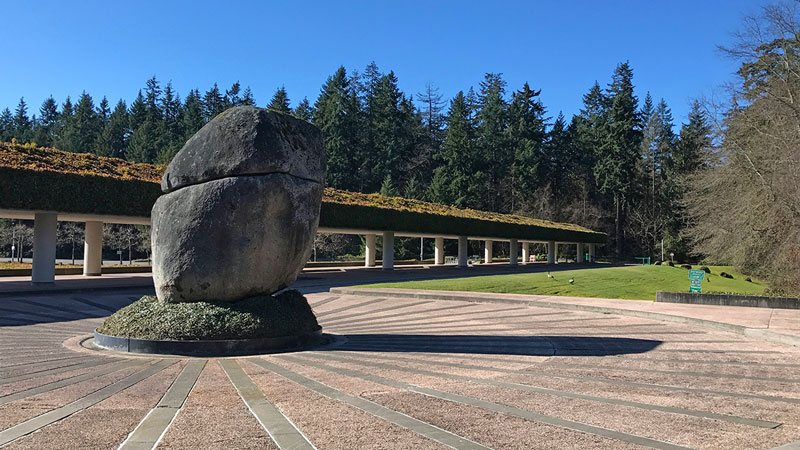
Weyerhaeuser International Headquarters, Federal Way, WA. Photo by Charles A. Birnbaum. Courtesy of The Cultural Landscape Foundation.
The SAH Heritage Conservation Committee wrote the following letter to Mr. Jim Ferrell, mayor of the City of Federal Way, and Col. Alexander Bullock, Seattle District Commander, expressing concerns about the proposed alterations to the Weyerhaeuser International Campus.
PDF Version
23 February 2021
Mr. Jim Ferrell, Mayor
City of Federal Way
33325 8th Avenue South
Federal Way, WA 98003
Jim.Ferrell@cityoffederalway.com
Col. Alexander Bullock, Seattle District Commander
U.S. Army Corps of Engineers
P.O. Box 3755
Seattle, WA 98124-3755
Alexander.l.bullock@usace.army.mil
Re: Proposed alterations to the Weyerhaeuser International Campus
Dear Mr. Ferrell and Col. Bullock:
The Society of Architectural Historians (SAH) expresses concerns about the proposed alterations to the Weyerhaeuser International Campus.
The Weyerhaeuser International Campus was designed by architect Edward Charles Bassett of Skidmore, Owings & Merrill and landscape architect Peter Walker of Sasaki, Walker and Associates. The 425-acre campus, completed in 1972, is nationally significant. While not listed on the National Register of Historic Places, it remains one of the finest modern corporate complexes in the United States, and in our opinion is eligible for listing as a National Historic Landmark.
George Weyerhaeuser, the CEO of one of the world’s largest private owners of timberland, personally selected Bassett and Walker to design the Weyerhaeuser campus. His stated wish was that the headquarters reflect not only the fact that Weyerhaeuser had been located in the Seattle area for over a century, but that it reflect a harmonious union of architecture, designed landscape, and woodland, to serve as an example of the conservation ethic of the Pacific Northwest.
The headquarters, designed to accommodate 1,000 employees, was carefully integrated into the site by conceptually turning a high-rise office building onto its side and siting it in a gentle swale, to minimize its impact upon the landscape. The result was the creation of a dam on one side of the site (the headquarters building), which allows a stream to form a pond at the top of the valley. As described by Peter Walker, the idea was that, after each rain, a small amount of water would flow under the building and allow the meadow below to green and flower. Each level of the stepped building contained its own terraced parking lot connected to the building by way of a formal row of sycamore trees, selected to contract with the forest beyond. The surrounding forest was carefully managed, removing underbrush and creating footpaths for use by employees. The combined architecture and landscape designs of Edward Charles Bassett and Peter Walker present vision of the site that embraces building, designed landscape, and managed forest with equal commitment, a tiered experience with all parts essential to an understanding of the whole.
Industrial Realty Group (IRG), the current owner and developer of the site, has proposed 1.5 million square feet of warehouses engulfing 132 acres, including two warehouses adjacent to the headquarters building itself. The plan includes destruction of the southeastern wooded hill, which would destroy the views from within the building, as well as views of the building itself. As well, the construction of a series of enormous concrete warehouses, replete with concrete truck delivery bays, surface parking, and a soulless retention pond, irrefutably diminishes if not destroys the integrity of both architecture and landscape. Roads that were originally designed as simple circulation routes for parking will become heavily used truck routes. The landscape Weyerhaeuser saw as a public amenity, a park for both employees and the local community, will become mere circulation, and the site that was once envisioned as a built example of a conservation ethic will become a busy warehouse complex, heavily trafficked by semi-trailers belching plumes of exhaust; a site of environmental healing becomes nothing more than another example of its degradation and commodification.
We understand that the proposal was approved by the Federal Way Community Development Director, and is currently in review pursuant to Section 106. We continue to voice strong opposition to this project, however, as it portends irreversible damage to this iconic modernist melding of architecture and landscape. We note that a master plan, developed in 1981, exists for this property and that it is designed to accommodate development and change while protecting the designed landscape, managed forest, and conservation ethos of the Weyerhaeuser campus. It is unclear whether IRG has considered this plan, or whether the reviewing agencies are aware of its existence.
We join our colleagues at a constellation of local, regional, and national organizations voicing opposition to this project, including the Cultural Landscape Foundation, Save Weyerhaeuser Campus; the Washington Trust for Historic Preservation; Rainier Audubon; the Historical Society of Federal Way; SoCoCulture; Docomomo U.S.; the National Trust for Historic Preservation; and many others. We encourage IRG to return to the 1981 master plan, which allows for development, but carefully sites that development within the original vision of the campus.
The Society of Architectural Historians strongly opposes the current development proposed for the Weyerhaeuser International Campus.
Sincerely,
Bryan Clark Green, Ph.D., LEED AP BD+C
Chair, Society of Architectural Historians Heritage Conservation Committee
cc: Mr. Kenneth Breisch, Ph.D.; Mr. Jeffrey Cody, Ph.D.; Mr. Anthony Cohn, AIA; Mr. David Fixler, FAIA; Ms. Priya Jain, AIA; Mr. Theodore H. Prudon, Ph.D., FAIA, Ms. Pauline Saliga; Ms. Deborah Slaton; Ms. Victoria Young, Ph.D.; Members, SAH Heritage Conservation Committee; Sen. Patty Murray; Sen. Maria Cantwell; Rep. Adam Smith; Gov. Jay Inslee; Dow Constantine, King County; Charles Birnbaum, The Cultural Landscape Foundation; Chris Moore, Washington Trust for Historic Preservation; Eugenia Woo, DocomomoWeWa; Elizabeth Waytkus, DocomomoUS; Barbara McMichael, SoCoCulture; Councilmember Pete von Reichbauer, King County; State Sen. Claire Wilson; State Rep. Jesse Johnson; State Rep. Jamila Taylor; City Council Pres. Susan Honda, Federal Way; Jaime Loichinger, Advisory Council on Historic Preservation; Bill Sterud, Puyallup Tribe of Indians; Lori Sechrist, Save Weyerhaeuser Campus; Michelle Connor, Forterra; Diana Noble Gulliford, Historical Society of Federal Way.